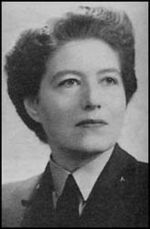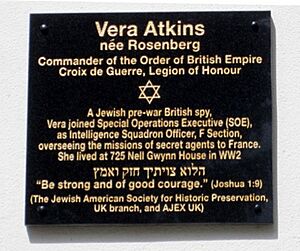Vera Atkins facts for kids
Quick facts for kids
Vera Atkins
|
|
|---|---|

Squadron Officer Vera Atkins, WAAF, in 1946
|
|
| Born |
Vera May Rosenberg
15 June 1908 |
| Died | 24 June 2000 (aged 92) |
| Occupation | SOE F Section intelligence officer |
Vera May Atkins (born June 15, 1908 – died June 24, 2000) was a brave British intelligence officer. She was born in Romania. During the Second World War, from 1941 to 1945, she worked for a secret organization called the Special Operations Executive (SOE). Her job was to help agents in France.
Contents
Vera Atkins' Early Life
Vera Atkins was born Vera May Rosenberg in Galați, Kingdom of Romania. Her father, Max Rosenberg, was a German-Jewish businessman. Her mother, Zefra Hilda, was British-Jewish. Vera had two brothers.
She briefly studied languages at the Sorbonne in Paris. She also went to a finishing school in Lausanne, where she loved skiing. Later, she trained at a secretarial college in London.
In 1932, her father lost his money and passed away a year later. Vera stayed with her mother in Romania. But the political situation in Europe became dangerous. So, in 1937, they moved to Great Britain.
Vera grew up on a large family estate in Crasna (now in Ukraine). She enjoyed the lively social scene in Bucharest. She became friends with the German ambassador, Friedrich Werner von der Schulenburg. He was against the Nazis.
Later, Vera became close to a young British pilot named Dick Ketton-Cremer. He was killed in action in 1941. Vera never married. She lived with her mother until 1947.
While in Romania, Vera met several British intelligence officers. They later helped her become a British citizen. She may have shared information with them because her family strongly supported Britain. Vera also worked as a translator for an oil company.
She changed her last name to Atkins, which was her mother's maiden name. Vera was also a cousin of Rudolf Vrba, who was famous for escaping Auschwitz.
Before the war, a Canadian spy leader, Sir William Stephenson, recruited Vera. He sent her on secret trips across Europe. Her task was to gather information about the growing threat from Nazi Germany. She shared this information with Winston Churchill.
Vera's First Secret Missions
Before joining SOE, Vera traveled to the Low Countries in 1940. She went to deliver money for a bribe. This was to help her cousin, Fritz, get a passport to escape Romania.
Vera got stuck in the Netherlands when the Germans invaded. She had to hide. She finally returned to Britain in late 1940. A Belgian resistance group helped her. Vera kept this mission a secret her whole life.
Before working for SOE, Vera volunteered as an Air Raid Precautions warden in Chelsea. She lived at Nell Gwynn House during this time.
Joining the Special Operations Executive
In February 1941, Vera Atkins joined the French section of the SOE. Even though she was not yet a British citizen, she started as a secretary. Soon, she became an assistant to the section head, Colonel Maurice Buckmaster. She quickly became a key intelligence officer.
Vera worked as a civilian until August 1944. Then, she became a Flight Officer in the Women's Auxiliary Air Force (WAAF). In February 1944, she officially became a British citizen. She was later named F Section's intelligence officer.
Vera's main job at SOE was to find and send British agents into France. France was occupied by enemy forces then. She was also responsible for the 37 women SOE agents. These women worked as couriers and radio operators.
Vera took care of many details for the agents. She checked their clothes and papers to make sure they looked right for their missions. She sent letters to their families and made sure they got paid. Vera often went with agents to the airfields. She would do final security checks before they left for France.
Vera attended daily meetings with section leaders. She often stayed late at night in the signals room. There, she waited for secret messages from agents in the field. She usually arrived at the SOE office around 10:00 AM.
Many colleagues did not like Vera. But Colonel Buckmaster trusted her. He valued her honesty, amazing memory, and good organization skills. She was tall, about 5 feet 9 inches. She usually wore smart skirt-suits. She smoked cigarettes her whole life.
Finding Missing Agents
After France was freed and the war ended in Europe, Vera went to France. She also spent four days in Germany. She was determined to find out what happened to the 51 missing SOE agents. These agents had disappeared in enemy territory. She later confirmed that 117 of them had died while captured by the Germans.
At first, she did not get much help from the British government. But as the terrible stories of Nazi atrocities became known, people wanted war criminals to be tried. So, the government decided to support Vera's search. They wanted to find out what happened to the agents and bring those responsible to justice.
The SOE closed down at the end of 1945. But in January 1946, Vera went to Germany. She was now a Squadron Officer in the Women's Auxiliary Air Force. Her mission was to find the missing agents, including 14 women. She worked with the war crimes unit of the British Army.
Until October 1946, Vera searched for the missing SOE agents. She also questioned Nazi war crime suspects. This included Rudolf Höss, who was the former commander of Auschwitz-Birkenau. Vera also gave evidence in trials.
In November 1946, Vera's mission was extended. She returned to Germany to help with the Ravensbrück trial. This trial lasted until January 1947. She used this chance to finish her search for Noor Inayat Khan. Vera found out that Noor had died at Dachau, not Natzweiler-Struthof as she first thought.
Vera found out what happened to 117 of the 118 missing F Section agents. She also learned how all 14 women agents died. Twelve of them died in concentration camps:
- Andrée Borrel, Vera Leigh, Sonia Olschanezky, and Diana Rowden were executed at Natzweiler-Struthof on July 6, 1944.
- Yolande Beekman, Madeleine Damerment, Noor Inayat Khan, and Eliane Plewman were executed at Dachau on September 13, 1944.
- Denise Bloch, Lilian Rolfe, and Violette Szabo were executed at Ravensbrück on February 5, 1945.
- Cecily Lefort was executed at the Uckermark Youth Camp in February 1945.
Yvonne Rudellat died of typhus on April 23 or 24, 1945, after Bergen-Belsen was freed. Muriel Byck died of meningitis in France on May 25, 1944.
Vera also convinced the War Office that these twelve women, who were civilians, should not be listed as having died in prison. Instead, they were recorded as having been killed in action.
Vera's hard work meant that each of her "girls" had a known place of death. She also helped make sure they received official recognition for their bravery. This included the George Cross for Violette Szabo in 1946 and Noor Inayat Khan in 1949.
Vera Atkins After the War
Vera left the military in 1947. She was nominated for an award but did not receive one at that time.
She then worked for UNESCO's Central Bureau for Educational Visits and Exchanges. She was the office manager from 1948 and director from 1952. She retired early in 1961 and moved to Winchelsea in East Sussex.
In 1950, Vera was an advisor for the film Odette. In 1958, she advised on the film Carve Her Name With Pride, about Violette Szabo. She also helped author Jean Overton Fuller with her book about Noor Inayat Khan.
Some people suspected Vera of being a spy for the Germans or Soviets. However, her biographer, Sarah Helm, says these claims are not true. She suggests Vera's secrecy was because she did not want to reveal her 1940 mission. Also, being a woman, Jewish, and not British in SOE might explain why she was defensive.
Vera convinced the official SOE historian, M.R.D. Foot, not to mention her Romanian background in his book. Until her death, she strongly defended the SOE's wartime actions. She made sure that the 12 women who died in the concentration camps were remembered. Memorial plaques were placed near where they died.
Vera also supported the memorial at Valençay in France. It was unveiled in 1991. This memorial honors the SOE agents in France who died serving their country.
In 1996, Vera wrote to The Daily Telegraph. She defended the decision to send Noor Inayat Khan to France. Vera wrote about Noor's success in avoiding capture, her escape attempts, and her harsh imprisonment. Vera stated, "This is the record of Noor Inayat Khan and her answer to those who doubted her."
Awards and Honors
Vera Atkins was awarded the CBE in 1997. She received the Croix de Guerre from France in 1948. In 1987, the French government made her a Knight of the Legion of Honour.
In 2022, a historical plaque was placed at Nell Gwynn House in London. This is where Vera lived during World War II. The plaque was put there by the Jewish American Society for Historic Preservation, U.K. Branch and the (British) Association of Jewish Ex-Servicemen and Women, Stamford Hill Branch.
Vera Atkins' Later Years and Death
Vera Atkins passed away at a hospital in Hastings on June 24, 2000. She was 92 years old. She had been recovering from a skin problem in a nursing home. She fell and broke her hip. While in the hospital, she caught an infection.
Her memorial plaque is shared with her brother Guy. It is on the northern wall at St Senara's churchyard in Zennor, Cornwall. Her ashes were scattered there. The inscription reads "Vera May Atkins, CBE Légion d'honneur Croix de guerre".


